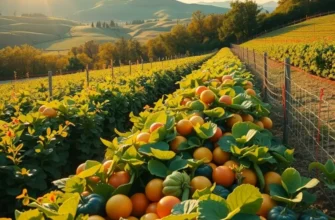Farm-to-table is more than a trend; it is a lifestyle choice that empowers environmentally-conscious individuals to make sustainable food decisions. By selecting locally sourced produce, consumers not only support their local economies but also minimize their environmental impact. This approach promotes a return to the roots of food production, fostering healthier communities and a planet-friendly way of living. Understanding the principles behind farm-to-table can inspire you to adopt these practices in your daily life, making a significant difference for the environment.
Understanding Farm-to-Table: Why It Matters

The farm-to-table movement embodies principles that are not only essential for achieving dietary quality but also crucial for the health of our planet. This movement champions local sourcing, which fundamentally means buying and eating food produced in proximity to where it is consumed. Local sourcing does more than promote freshness and flavor; it supports local economies and fosters community bonds among farmers and consumers.
When you choose farm-to-table options, you prioritize seasonal eating, aligning your diet with the natural harvest cycle. Consuming seasonal produce ensures that foods are picked at their peak of ripeness and nutritional quality. This practice significantly reduces the need for long-haul transportation and artificial storage conditions, which can diminish food quality and negative environmental impacts.
Reducing the carbon footprint is one of the most compelling reasons to adopt farm-to-table habits. Large-scale agricultural practices and long-distance food transportation contribute heavily to greenhouse gas emissions. By purchasing from local farms, we cut down on emissions related to fuel consumption and refrigeration. This choice directly impacts the planet in a positive way, potentially slowing climate change and reducing pollution.
Moreover, farm-to-table practices contribute to environmentally sustainable agriculture. Many small and local farms engage in practices such as crop rotation, organic farming, and Integrated Pest Management (IPM). These methods preserve soil fertility, promote biodiversity, and minimize chemical usage, contributing to ecological balance and resilience.
Choosing farm-to-table options benefits not just the environment but also enriches personal health and community welfare. Local produce typically retains more nutrients due to shorter time spans between harvest and consumption, which means better quality produce on your plate. Additionally, supporting local farmers adds to regional economic stability by keeping food dollars circulating within the community, rather than transferring wealth to distant corporations.
For those interested in practical ways to embrace this lifestyle, consider how reduced food storage waste contributes to sustainability. Examine methods to improve your food storage with efficient techniques to ensure freshness and decrease spoilage. Explore methods like eco-smart kitchen storage for practical ways to incorporate these ideas into your daily life.
Collectively, these elements of the farm-to-table movement represent a compelling approach to food consumption and agricultural support. By understanding and implementing farm-to-table principles, consumers can play a direct role in fostering a healthier planet and future.
How to Embrace Farm-to-Table in Daily Life

Adopting the farm-to-table movement is easier than it seems. It begins with understanding the importance of choosing local produce. By frequenting your local farmers’ markets, you support regional agriculture while ensuring your food is fresh and flavorful. Keep an eye out for vendors who practice sustainable farming methods. Not only are these practices better for the environment, but they also mean the produce is often grown without synthetic pesticides.
Understanding seasonal produce is another crucial step. Seasonal eating means enjoying fruits and vegetables at their peak nutrient density. It might feel challenging at first, yet with practice, it becomes second nature. You can use online resources or local guides to determine which produce is in season. Plan your meals around these items, which are often more abundant and affordable.
Exploring Community Supported Agriculture (CSA) is a game-changer for integrating the farm-to-table ethos into your lifestyle. By subscribing to a CSA, you receive a box of seasonal produce directly from a farm. This not only fosters a deeper connection with local farmers but also introduces a delightful element of surprise to your cooking. You may discover new vegetables and flavors, offering a chance to expand your culinary skills.
Growing your own food, even in small quantities, can be incredibly rewarding. Herbs like basil, mint, or parsley can thrive in pots on a sunny windowsill. For those with more space, try planting vegetables such as tomatoes or peppers in a garden. The act of nurturing plants from seed to harvest builds a connection to the land and an appreciation for the food it provides.
Adapt your food storage practices to complement your sustainable choices. Reducing food waste is essential, and proper storage can extend the shelf life of your produce. For practical tips on how to store food efficiently to minimize waste, check out eco-smart kitchen storage.
Finally, incorporate these principles into your cooking and dining routines. Experiment with minimal-prep recipes that allow the natural flavors of your ingredients to shine. By embracing the simplicity of seasonal cooking, you’ll find it easier to maintain this lifestyle.
Transitioning to a farm-to-table approach doesn’t mean you need to overhaul your entire diet overnight. Start small, perhaps with one farm-to-table meal a week, and gradually increase as you become more comfortable with the process. Each mindful choice you make brings personal health benefits and contributes positively to the planet.
Final words
The farm-to-table movement is more than just a food sourcing method; it’s a lifestyle committed to nourishing our bodies while caring for the planet. By prioritizing local, organic, and sustainable practices, each meal can contribute to a healthier environment. Implement the simple strategies discussed in this article, from sourcing local produce to growing your own food, and be part of a larger movement dedicated to protecting and preserving our Earth. Your choices matter, and every action you take is a step toward a more sustainable future.








